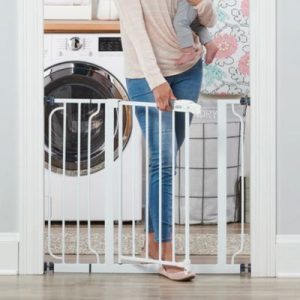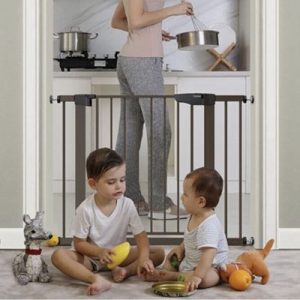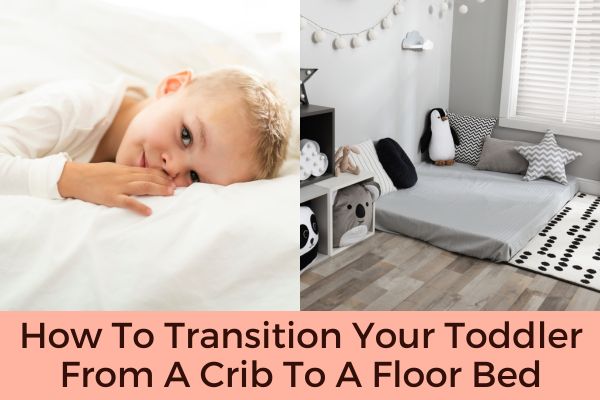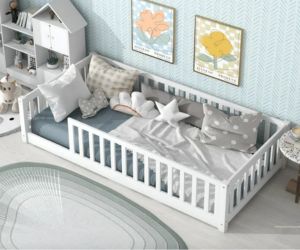When my kid turned one, she started climbing out of her crib.
With her active, cheeky, and “assertive” attitude, I knew we won’t be able to stop her unless we take away the thrill of climbing.
And that means, no more crib and we’d be transitioning to a Montessori floor bed.
I was dreading it.
I was worried that she won’t be able to sleep at night or even take a nap on a floor bed.
That she’ll just keep on standing up and playing with her toys.
That she’ll roam out of her bedroom and get hurt or worse.
It took a few months, some of my sanity, and some help from my husband but we made it.
I successfully transitioned my toddler from the crib to a floor bed! And at the time of this article’s publishing, she’s 5 years old and still sleeps there!
I sometimes wished though that I had a guide then to tell me exactly what to expect when making this crib-to-floor bed transition.
I wished I knew how to mentally prepare for it.
How to set up her room, how to childproof it, and what not to do when transitioning my toddler to a floor bed.
Hence, I made this guide.
Because I don’t want any new-ish moms to feel like what I felt before – to feel anxious about preparing their toddler to transition to a floor bed.
I want you to feel mentally and emotionally prepared. I want you to feel less frustrated and I want you to kinda enjoy this mid-transition, instead of stressing over it.
But first, if you’re curious to know a little bit more about Montessori beds, keep scrolling below.
I hope you’ll love the products we recommend! Just a quick note: if you click on a product link below and decide to buy it, we may earn a small commission.
List of Contents
What is a Montessori Floor Bed?
A Montessori floor bed is a mattress placed directly on the floor, allowing children the freedom to move in and out of bed independently.
Unlike traditional cribs or toddler beds, it promotes a sense of autonomy and controls over their sleep routine.
Related Article: Best Crib Alternatives For Small Spaces
In its simplest sense, it’s a bed on the floor that’s easy for young children to use without adult assistance.
When to Start Using a Montessori Floor Bed?
According to the American Academy of Pediatrics (AAP), once your toddler is climbing out of their crib, it’s time to transition them to a “big kid” bed
They didn’t specify what type of bed but according to the Nationwide Childrens Organization, some parents introduce a Montessori floor bed at around 6 months.
While others wait until their kid is around 2 years old.
I would recommend looking at your child’s temperament, safety, and your own personal comfort before making the switch.
We are all different so just make the judgment based on your needs and circumstances.
I knew I had to switch my toddler from the crib to the floor bed because of safety reasons.
I didn’t have much of a choice but if I didn’t have a crackhead monkey (and I say that with love), I probably would have waited until she was old enough.
Old enough to talk, and big enough to climb safely in and out of a toddler bed.
My kid started walking at 8 months old but didn’t talk coherently until she was 2.5 years old.
And there she was, transitioning to a floor bed at 1 year old.
Pros and Cons of Using a Floor Bed
Here are some disadvantages and benefits of using a floor bed for your toddler. Know this to prepare yourself mentally.
Pros of Using a Montessori Floor Bed
A Montessori floor bed offers numerous benefits such as:
- safe for climbers (like my cheeky monkey)
- promotes independence, allowing children to explore and move freely
- fosters physical development and coordination
- creates a cozy and inviting sleep environment, leading to better sleep quality
Cons of Using a Floor Bed
Here are a few potential downsides to using a floor bed for toddlers:
- May have trouble staying in bed
- Child may fall out of bed
- Challenging to clean
- Childproofing the entire room is a must
Toddler Tips For Transitioning to a Montessori Floor Bed
Here are the ultimate tips for transitioning your toddler from a crib to a floor bed. Let’s start with the mental tips:
Manage your expectations
Remember that whatever you learn in articles, websites, videos, forums, etc., are just guides to help you learn something.
Like this transitioning to a floor bed.
This will not give you the be-all-end-all solutions.
It doesn’t mean that when you follow this step, that step, and so on, you’ll get the exact results.
So you have to learn to manage your expectations.
Try to understand that every child is different and for some, they can easily transition to a floor bed. But for some, it might be difficult and they might need more time.
And your kid might be one of them.
Get into the right frame of mind
And that is to stay patient and flexible throughout the transition process.
Let go of any concerns or doubts you may have and approach the transition with a positive mindset.
Stay calm, cool, and collected. Remember your child will have a hard time as one their brains are still developing and two, this is a new thing for them. They’re not used to it and they need your guidance.
So work on being patient, flexible, and being positive.
You need to build these skills as eventually, if you haven’t yet, you’re going to need these skills to teach your toddler to brush their teeth, give up their night bottle, potty train them, and more!
Talk to your child about the upcoming change
Before making the switch, have a conversation with your toddler about transitioning to a floor bed.
You’d be surprised by how much they can understand and learn if you talk in a simple and age-appropriate language!
If your kid is older and has more opinions about the matter, let them express their thoughts and feelings about the transition.
They might get excited or they might not like it, or they might not even fully understand what you mean.
I talked to my 1-year-old child then about the transition and she couldn’t care less. So that was that, lol.
Nevertheless, for kids who are resistant to the change, reassure them that what they’re feeling is normal and valid.
This helps them feel heard and involved in the decision-making process.
Childproof the room
This is one of the most important physical steps in making the transition from crib to floor bed – childproofing your kid’s bedroom.
These childproofing steps can be a bit long but it’s better to be safe than sorry:
- Secure or change furniture
Anchor heavy furniture, such as dressers, and changing tables to the wall to prevent tipping over.
If you’re still worried about any furniture falling on your kid or being climbed on by your kid, then just remove them from the nursery room. Temporarily.
My kid’s room then had built-in cabinets, the floor bed with playmats, a stand fan, and her old crib (I used it to change her diapers so she won’t be able to run away. Luckily she wasn’t interested in climbing it again, lol), and some toys and books.
That’s it.
My husband had to tie up the stand fan on the window frame, just to make sure it won’t tip over if my daughter decides to push it because that’s how wild my little one can be.
- Install baby gates
This was a lifesaver for me.
I knew we had to install one because I couldn’t just let my daughter walk freely around the house.
I can’t supervise her 24/7 as I need to do chores and work.
So baby gates are a must.
Use baby gates at the door and the top and bottom of stairs if needed.
Regalo Easy Step 38.5-Inch Baby Gate

Cumbor 29.7″-40.6″ Baby Gate

- Lock cabinets and drawers
Install childproof locks or latches on cabinets and drawers within your child’s reach.
If you can open it, put a lock or latch on it!
- Cover electrical outlets
A big-must. Install outlet covers or safety plugs in all electrical outlets to prevent your child from inserting objects or fingers into them.
- Remove small objects
Keep small objects, such as coins, buttons, or small toys, out of your child’s reach to prevent choking hazards. And regularly inspect your kid’s room for any potential choking hazards.
- Remove objects they can stand or climb on
No chair, no stool, no short tables.
Not even an activity table for activity cubes for toddlers.
I learned that the hard way.
My kid was inside her childproofed room with a baby gate and I was folding the laundry just outside the gate.
I decided to give her this activity cube toy that I got for her first birthday, to distract her from wanting to get out of her room. As I wanted to fold the laundry quickly, in peace.
I placed the activity inside her room, right beside the gate.
Then I turned away for 3 seconds.
When I looked back at her, SHE WAS STANDING ON TOP OF THE FREAKING ACTIVITY CUBE.
Which looked like this:

Like how the fuck did she managed to climb on top, without falling over?!! Almost gave me a fucking heart attack.
So we considered giving her some of the best climbing toys for 1 year olds instead.
- Secure cords and blinds
Keep blind cords, curtain cords, and electrical cords out of reach by using cord safety devices or cord winders.
Use cord cleats or cord shorteners to keep cords safely out of your child’s reach.
Consider using window blinds with cordless options to eliminate the risk of strangulation from window cords.
- Baby-proof windows
Install window guards or window locks to prevent your child from accidentally opening windows and falling out.
Keep furniture away from windows to discourage climbing.
- Cover sharp corners and edges
Use corner protectors or edge guards on furniture with sharp corners and edges, to prevent injuries from bumps or falls.
- Secure rugs and mats
Use non-slip mats or rug grips to secure rugs and mats to the floor, preventing your child from slipping or tripping.
Related Article: Best Rugs For Babies To Crawl On (Washable and Non-Toxic)
- Keep toiletries out of reach
Store toiletries, such as lotions, creams, and diaper rash ointments, in childproof locked cabinets and drawers, to avoid accidental ingestion or spills.
- Use door stoppers
Install door stoppers or door guards to prevent doors from accidentally closing and trapping fingers and hurting little toes.
Make the room boring
While I understand the notions and benefits of the Montessori method of promoting independence and giving a child easy access to their belongings, I knew my daughter.
I knew her well enough that if I arranged the room in such a way that she can easily access all her toys and books, she wouldn’t sleep.
I wanted my kid to associate her bedroom with sleeping.
So I removed all her toys, books – anything exciting that she can look at and play with inside her bedroom.
I wanted her to get bored and just go straight to bed.
Which worked!
Of course, I gave her the toys and everything, after she slept.
I gradually left one or two books and toys, until I was confident enough to leave her a library of books and a box of toys.
Cause I knew then she would still go to bed to sleep, even with all the entertainment around her.
So consider making your kid’s room boring AF, initially.
So they can associate their room with sleeping, making it easy for them to transition from crib to Montessori floor bed.
Choosing the right floor bed
Most would go for Montessori floor beds where it’s mostly tailored for toddlers, such as the ones below:
Personally, I think any bed will do, as long as your child can safely stay on it, and climb in and get out of it.
We used a Queen-sized bed on the floor that I surrounded with playmats.
Since she was already more than a year old and was physically advanced for her age, I knew it was safe to use pillows.
So I strategically placed pillows at the head and foot of the bed.
I co-sleep my toddler by the way, so my daughter then would lay next to the wall, while I’d lay on the other side.
Then I taught her how to get off the bed safely, as the bed mattress was a little too thick and required some maneuvering for a 1 year old.
But hey she made it.
So my point is, just choose a bed that meets your budget and comfort level. Then teach your kid how to use it.

Keep the pets away, initially
Now this would be tricky if your pets are used to going in and out of your daughter’s room.
If that’s the case, then just ignore this step.
If you haven’t allowed your pets yet to go in and out of the nursery room, then keep them out a bit longer.
You need to keep them out at first, as your child would get distracted every time your pets come in.
It would give your little one an excuse to get out of bed and play with your cats or dogs, instead of sleeping in.
So just wait until your kid is old enough to understand that they need to stay in bed and get some sleep, even if the pets are inside their room.
FAQ: Transitioning From Crib To Floor Bed
How do I transition to a Montessori floor bed?
You can transition to a Montessori floor bed by 1st, mentally preparing for it, 2nd, talking to your child about it, 3rd childproofing and preparing the bedroom and 4th, and choosing the bed.
When can I move my baby to a floor bed Montessori?
You can move your baby to a floor bed Montessori at any age that you’re comfortable with.
What age is a Montessori bed good for?
Ideally, an age where the child is capable of staying in the bed safely and is comfortable getting in and out of it safely is the best age for a Montessori bed.
Takeaway on Transitioning to a Montessori Floor Bed
The most important tip here is to always manage your expectations.
I didn’t know how to back then and it caused me a lot of frustration and anger.
I wished I knew then what I knew now, so always remember that first and foremost – manage expectations.
Other than that, on the bare minimum, just remember to install a baby gate, childproof the room and y’all be good in transitioning to a Montessori floor bed.
Good luck!





